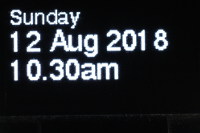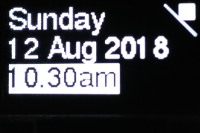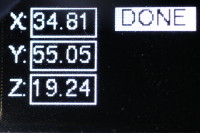13 KiB
Writer and Cwriter classes
These classes facilitate rendering Python font files to displays where the
display driver is subclassed from the framebuf class. Examples are:
- The official SSD1306 driver.
- The PCD8544/Nokia 5110.
- The Adafruit 0.96 inch color OLED with this driver.
- The Adafruit 1.5 inch color OLED and the Adafruit 1.27 inch color OLED with this driver for STM32 (Pyboards etc) or this one for other targets.
- The HX1230 96x68 LCD.
- A driver for Sharp ultra low power consumption monochrome displays such as 2.7 inch 400x240 pixels is here.
- Drivers for Adafruit ST7735R based TFT's: 1.8 inch and 1.44 inch are here.
- Drivers for ePaper displays documented here
Basic support is for scrolling text display using multiple fonts. The nanogui module has optional extensions for user interface objects displayed at arbitrary locations on screen.
Example code and images are for 128*64 SSD1306 OLED displays.
Scrolling text, multiple fonts.
A field containing variable length text with a border.
Labels and Fields (from nanogui.py).
Contents
- Introduction
1.1 Hardware
1.2 Files
1.3 Fonts - Writer and CWriter classes
2.1 The Writer class For monochrome displays.
2.1.1 Static Method
2.1.2.Constructor
2.1.3 Methods
2.2 The CWriter class For colour displays and for upside-down rendering.
2.2.1 Static Method
2.2.2 Constructor
2.2.3 Methods
2.2.4 A performance boost - Notes
Main README
1. Introduction
The original Writer class was a proof of concept intended to demonstrate
rendering, on an SSD1306 OLED display, fonts created byfont_to_py.py.
This update for practical applications has the following features:
- Genarality: capable of working with any
framebufderived driver. - Multiple display operation.
- Text display of fixed and variable pitch fonts with wrapping and vertical scrolling.
- Wrap/clip options: clip, character wrap or word wrap.
- Tab support.
- String metrics to enable right or centre justification.
- Inverse (background color on foreground color) display.
- Inverted display option.
Note that these changes have significantly increased code size. On the ESP8266
it is likely that writer.py will need to be frozen as bytecode. The original
very simple version still exists as writer_minimal.py.
1.1 Hardware
Tests and demos assume a 128*64 SSD1306 OLED display connected via I2C or SPI.
Wiring is specified in ssd1306_setup.py. Edit this to use a different bus or
for a non-Pyboard target.
1.2 Files
writer.pySupportsWriterandCWriterclasses.writer_gui.pyProvides optional GUI objects.ssd1306_setup.pyHardware initialisation for SSD1306. Requires the official SSD1306 driver.writer_demo.pyDemo using a 128*64 SSD1306 OLED display. Import to see usage information.writer_tests.pyTest/demo scripts. Import to see usage information.writer_minimal.pyA minimal version for highly resource constrained devices.
Sample fonts:
freesans20.pyVariable pitch font file.courier20.pyFixed pitch font file.font10.pySmaller variable pitch fonts.font6.py
1.3 Fonts
Python font files should be created using font-to-py.py using horizontal
mapping (-x option). The -r option is not required. If RAM is critical
fonts may be frozen as bytecode reducing the RAM impact of each font to about
340 bytes.
Contents
2. Writer and CWriter classes
The Writer class provides fast rendering to monochrome displays using bit
blitting. Most applications will use this class.
The CWriter class is a subclass of Writer. It can optionally support color
displays. It provides additional functionality in the form of an upside-down
display option. Owing to limitations in the frmebuf.blit method the
CWriter class renders glyphs one pixel at a time; rendering is therefore
slower than the Writer class.
Multiple screens are supported. On any screen multiple Writer or CWriter
instances may be used, each using a different font. A class variable holds the
state of each screen to ensure that the insertion point is managed across
multiple instances/fonts.
Contents
2.1 The Writer class
This class facilitates rendering characters from Python font files to a device,
assuming the device has a driver subclassed from framebuf. It supports three
ways of handling text which would overflow the display: clipping, character
wrapping and simple word wrapping.
It handles newline and tab characters, black-on-white inversion, and field blanking to enable variable length contents to be updated at a fixed location.
Typical use with an SSD1306 display and the official driver is as follows:
from ssd1306_setup import WIDTH, HEIGHT, setup
from writer import Writer
import freesans20 # Font to use
use_spi=False # Tested with a 128*64 I2C connected SSD1306 display
ssd = setup(use_spi) # Instantiate display: must inherit from framebuf
# Demo drawing geometric shpes
rhs = WIDTH -1
ssd.line(rhs - 20, 0, rhs, 20, 1) # Demo underlying framebuf methods
square_side = 10
ssd.fill_rect(rhs - square_side, 0, square_side, square_side, 1)
# Instantiate a writer for a specific font
wri = Writer(ssd, freesans20) # verbose = False to suppress console output
Writer.set_textpos(ssd, 0, 0) # In case a previous test has altered this
wri.printstring('Sunday\n12 Aug 2018\n10.30am')
ssd.show()
The file writer_demo.py illustrates the use of font files with a 128*64
SSD1306 OLED display and the official
SSD1306 driver.
2.1.1 Static Method
The Writer class exposes the following static method:
set_textposArgs:device,row=None,col=None. Thedeviceis the display instance. This method determines where on screen subsequent text is to be rendered. The initial value is (0, 0) - the top left corner. Arguments are in pixels with positive values representing down and right respectively. The insertion point defines the top left hand corner of the next character to be output.
Where None is passed, the setting is left unchanged.
Return: row, col current settings.
The insertion point applies to all Writer instances having the same device.
The insertion point on a given screen is maintained regardless of the font in
use.
2.1.2 Constructor
This takes the following args:
deviceThe hardware device driver instance for the screen in use.fontA Python font instance.verbose=TrueIfTruethe constructor emits console printout.
2.1.3 Methods
printstringArgs:string,invert=False. Outputs a text string at the current insertion point. Newline and Tab characters are honoured. IfinvertisTruethe text is output as black on white.heightNo args. Returns the font height in pixels.stringlenArg:string. Returns the length of a string in pixels. Used for right or centre justification.set_clipArgs:row_clip=None,col_clip=None,wrap=None. Ifrow_clipand/orcol_clipareTrue, characters will be clipped if they extend beyond the boundaries of the physical display. Ifcol_clipisFalsecharacters will wrap onto the next line. Ifrow_clipisFalsethe display will, where necessary, scroll up to ensure the line is rendered. IfwrapisTrueword-wrapping will be performed, assuming words are separated by spaces.
If any arg isNone, that value will be left unchanged.
Returns the current values ofrow_clip,col_clipandwrap.tabsizeArgvalue=None. Ifvalueis an integer sets the tab size. Returns the current tab size (initial default is 4). Tabs only work properly with fixed pitch fonts.
Contents
2.2 The CWriter class
This extends the Writer class by adding support for upside-down and/or color
displays. A color value is an integer whose interpretation is dependent on the
display hardware and device driver.
2.2.1 Static method
The following static method is added:
invert_displayArgsdevice,value=True. Thedeviceis the display instance. Ifvalueis set, causes text to be rendered upside down. Theset_textposmethod should be called to ensure that text is rendered from the bottom right hand corner (viewing the display in its normal orientation).
If a display is to be run inverted, this method must be called prior to
instantiating a Writer for this display.
2.2.2 Constructor
This takes the following args:
deviceThe hardware device driver instance for the screen in use.fontA Python font instance.fgcolor=NoneForeground color. IfNonea monochrome display is assumed.bgcolor=NoneBackground color. IfNonea monochrome display is assumed.verbose=TrueIfTruethe constructor emits console printout.
2.2.3 Methods
All methods of the base class are supported. Additional method:
setcolorArgs:fgcolor=None,bgcolor=None. Sets the foreground and background colors. If one isNonethat value is left unchanged. If both areNonethe constructor defaults are restored. Constructor defaults are 1 and 0 for monochrome displays (Writer). Returns foreground and background color values.
The printstring method works as per the base class except that the string is
rendered in foreground color on background color (or reversed if invert is
True).
2.2.4 A performance boost
Rendering performance of the Cwriter class is slow: owing to limitations in
the framebuf.blit method the class renders glyphs one pixel at a time. There
is a way to improve performance. It was developed by Jim Mussared (@jimmo) and
consists of a native C module.
On import, writer.py attempts to import a module framebuf_utils. If this
succeeds, glyph rendering will be substantially faster. If the file is not
present the class will work using normal rendering. If the file exists but was
compiled for a different architecture a warning message will be printed but the
class will work using normal rendering.
The directory framebuf_utils contains the source file, the makefile and a
version of framebuf_utils.mpy for armv7m architecture (e.g. Pyboards).
ESP32 users with access to the development toolchain should change Makefile
to specify the xtensawin arch and rebuild.
It is suggested that moving the appropriate framebuf_utils.mpy to the target
is only done once the basic operation of an application has been verified.
The native module does not support the CWriter.invert_display option. If this
is used, the presence of the native module will have no effect. The module has
no effect on the Writer class which uses fast rendering by default.
The module has a fast_mode variable which is set True on import if the mode
was successfully engaged. User code should treat this as read-only.
3. Notes
Possible future enhancements:
- General rendering to a rectangular area. This may be problematic as the
framebufscroll method is only capable of scrolling the entire buffer. - Extend word wrapping to cases where words are separated by tabs or hyphens.
- An asynchronous version.




